Better Buses II: Building the Network
October 1st, 2010 by ant6nThis is part II of a series on ideas how to make frequent bus services more attractive, see part I
The way the STM in Montréal built their frequent network is to label some already heavily used lines, and add some service during off peak hours here and there to get an all day 10 minute frequency. As far as I can see none of the lines were altered. Given that these routes evolved over time, according to ridership, alongside dozen of other lines that are not part of the frequent service now, it’s a bit surprising that the result actually does make for a decent network. It covers a large area of the city reasonably well and provides a good number of connections with itself and the metro.
In some other cities where users tried to map the their frequent bus service, the result is sometimes erratic, with routes concentrated in few corridors or only certain parts of the city. In Montreal the network almost looks as if the routes were specifically designed to form a network of their own. Almost, that is. There are some areas where the network could use some improvement. After all, the system did evolve with coverage in mind, rather than frequency. That means that on many corridors multiple lines overlap, so the individual lines provide less service. Building a frequent network thus requires some adjustments.
closing the gaps
A number of the bus lines terminates shortly before reaching other lines in the frequent service network. These gaps should be closed. A transit system is supposed to be a network, not just a set of corridors. More connections mean more choices in how you plan your trip, which means that users might be able to plan a shorter or faster trip. The possible advantages should really outweigh the resources required to extend a bus line a few hundred meters.
At the end of the lines, transit lines tend to run empty, which does not represent an efficient use of resources. This is because the only people on the bus will be the riders who have these stops as their destination. If passengers can connect to another service at the end of the line, there are more passengers who could use this segment.
Also, if the terminal station is a metro stop, there is some incentive to travel against the downtown flow. For example, if the 24 in the image above would connect to the Joliette metro station, the last couple of stops could act as a feeder to the metro, even for passengers going downtown – the metro is simply much faster than the bus.
consolidated lines are frequent lines
From the frequent service map it becomes quite obvious that although the East of Montreal has a fair number of frequent lines covering a large area, the West Island only has 2 lines — and those only go downtown every 10 minutes from 9h to 14h, and in the other direction thereafter.
One might remark that the West Island is generally more suburban — car ownership levels are higher, and the density is lower. But there does exist some bus service. And along some corridors buses are fairly frequent.
But it seems to have evolved with the desire to create coverage and one-seat rides, rather than frequency and working network. On some corridors (for example on sections of St Jean, Saint Charles, Pierrefonds, Lakeshore, Des Sources) there are multiple overlapping lines, that converge, and diverge after traveling together. Together they almost provide frequent service already — or at least several buses an hour. Some overlapping lines are scheduled so that there are a couple of buses in short succession, and then none for 20 to 25 minutes. There is potential to consolidate these lines and provide more lines on the map, without having to spend too many extra resources. An easy and frequent grid (like in the East of Montreal) could also attract more riders, who currently use their car; according to the motto “if you build it, they will come”.
There is a similar potential in the North East of Montreal, where several of the half-frequent lines overlap. It seems that consolidating lines could yield all-day frequent service lines.
more connections
As mentioned before, closing gaps can improve the network and could mean fewer transfers or faster travel for some people. Some gaps, that do not really look holes in the network, because there are lines – they are just not connected in a very convenient way. One example is the 105 bus:
Many riders would actually like to connect to the green metro line, and are thus forced to transfer to the orange line, and then the green line. Because the metro takes a detour, and extra transfers are needed, this can be quite an inconvenience. Commenter Zoltán puts it like this:
Yet they still can’t quite bear to create a frequent Sherbrooke line, one of the most obvious possibilities of a simple Montreal bus network, by merging the 24 and 105, with a short diversion (about 500m) to serve Vendôme.
As for points on Décarie, the resources used to provide the frequent 24 could either provide a frequent shuttle from Vendôme to Villa Maria Metro, or more usefully could enhance frequency on the 17 running all the way via Décarie, with the 102 running all the way via Girouard.
Merging the 24 and the 105 is one possibility. It would create a pretty long line with somewhat uneven load along it, which might cause bunching one the one end and emptier buses on the other. One could also just run the 105 to the Atwater or Lionel-Groulx Metro station.
Either way, the goal should be to create a more complete network.
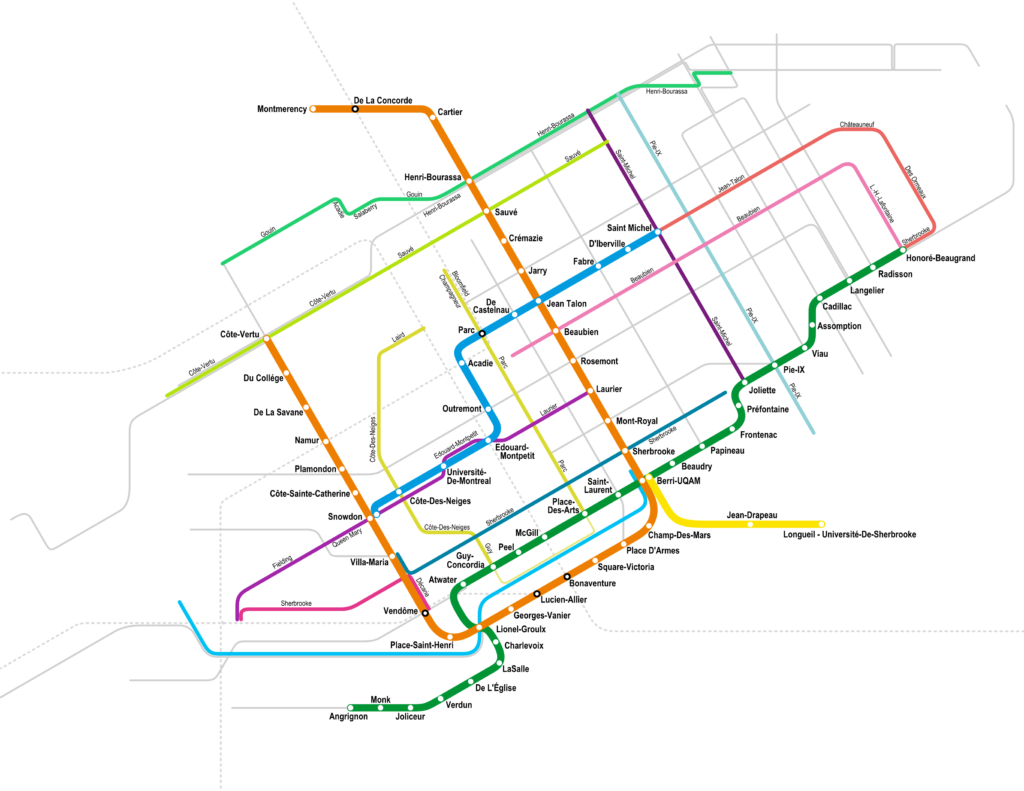
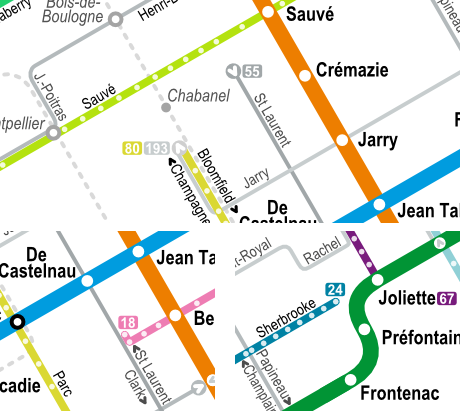
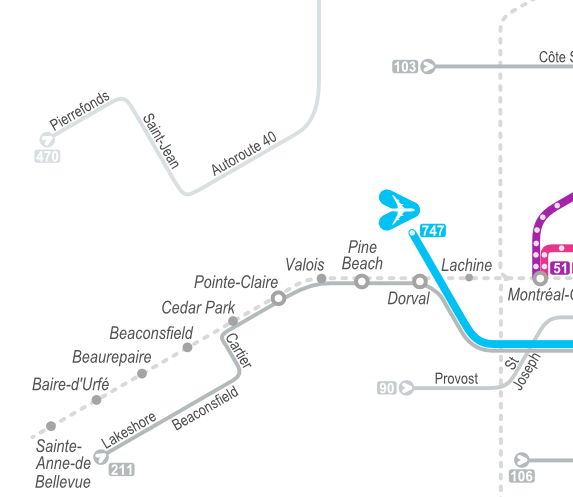
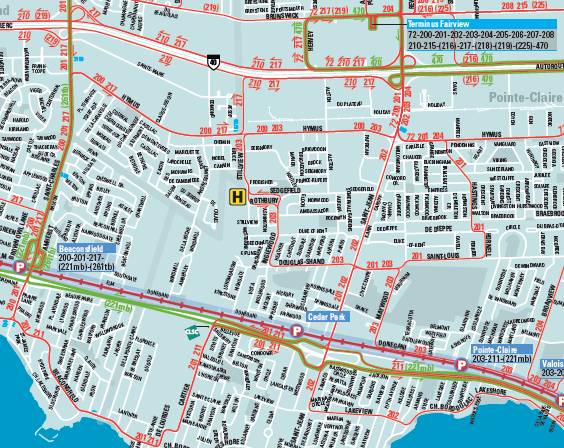
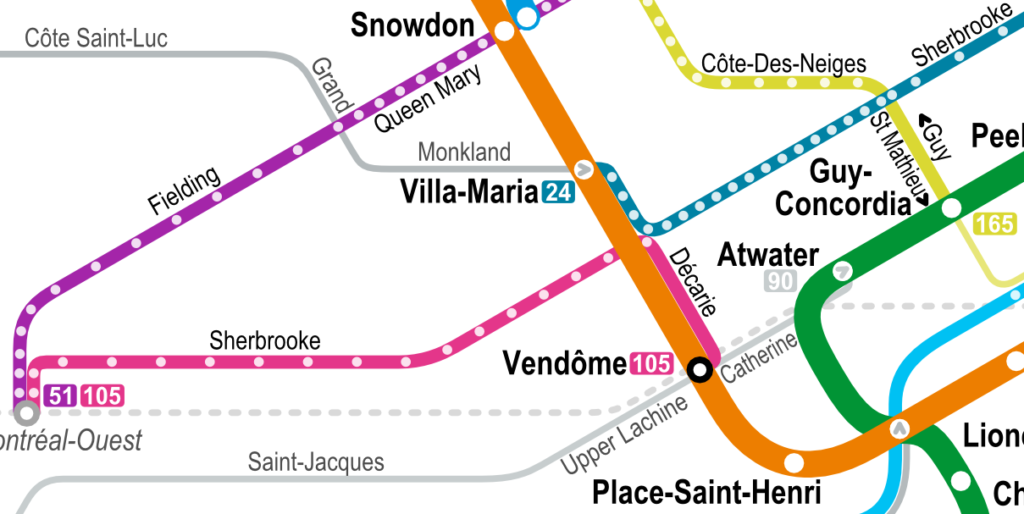
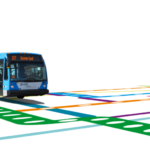
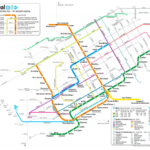
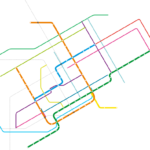
October 1st, 2010 at 11:35
The 105 is already unreliable during peak hours and snowstorms – bunching (usually eastbound) and empty buses (usually westbound) are not uncommon during these times. I’d hate to see what combining it with the 24 would do to this problem. Running it out to Atwater would be useful, but that’s a long way down Sainte Catherine (way further than your map suggests.)
If we had European levels of transit funding we’d run a S-Bahn-style train[*] down the tracks from Vendôme and get rid of the 105 entirely 🙂
[*] Small trains with frequent service and reasonably spaced stops as far as Montréal Ouest, neither of which the AMT provides.
October 1st, 2010 at 11:57
Yes I agree 100%. I am working on a blog post/proposal to exactly do that – build an S-Bahn along the Dorion-Rigaud line.
October 21st, 2010 at 03:56
I know this comment will sound kind of stupid, but I’m not an expert in transit, I just wanted to let you know that reading the posts about the maps you’re designing are inspiring and that I really like the look of the new map you made.
March 20th, 2012 at 10:10
I love this map and actually use it to make better use of the existing rapid bus lines. I actually made a new version, based on your map, with ideas for implementing an Ottawa-style Bus Rapid Transit system and coupling it with the metro. I hope you have the time to check out my map. It’s posted on this MTLurb.com forum:
http://www.mtlurb.com/forums/showthread.php/20093-Proposition-modeste-et-r%C3%A9aliste-pour-le-futur-des-transports-%C3%A0-MTL.
Love to hear what you’d think.
April 12th, 2012 at 23:36
Very interesting article, thank you for enlightening us with these views.
April 28th, 2017 at 12:33
This is going back a long time (2010 I know), but now that the 77 – Lionel-Groulx / CUSM exists, couldn’t you merge that and the 105? The 105 could terminate most of its routes at Vendôme/CUSM, and add trips between Lionel-Groulx and CUSM as necessary (I’m not familiar with ridership on the 77 as STM never release their numbers…). This adds the connection to the green line for the 105, especially at peak periods, and a connection between CUSM and Vendôme for those who might not be comfortable making the convoluted pedestrian trek between the two (and with the new station coming, who knows…).
Also, wouldn’t it make more sense to connect the 24 to Préfontaine? The 29 already serves Joliette, so there would be a bit of east-west redundancy (granted the 29 is infrequent), and the 24 terminates much closer to Préfontaine anyways. Anything longer and bus bunching becomes more and more of a problem.